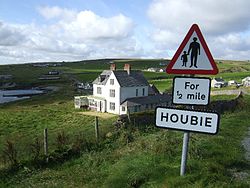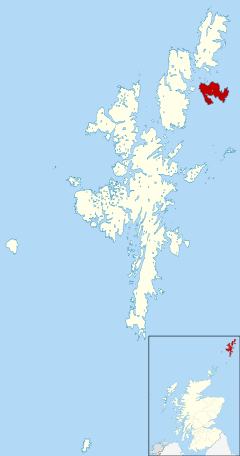Fetlar
| Fetlar | |
 Leagarth House, Houbie | |
|---|---|
| Main settlement: | Houbie |
| Location | |
| Location: | 60°37’12"N, 0°52’12"W |
| Grid reference: | HU620919 |
| Area: | 15.75 square miles |
| Highest point: | Vord Hill, 518 feet |
| Data | |
| Population: | 86 |
Fetlar is one of the North Isles of Shetland, with a population of 86 at the time of the 2001 census. Its main settlement is Houbie on the south coast, home to the Fetlar Interpretive Centre.
Fetlar is the fourth largest island of Shetland and has an area of some sixteen square miles. Its name is Norse and is believed to mean either "prosperous land" or "strapped together island".
Contents
History
One of the strange features of Fetlar is a huge wall that goes across the island known as the Funzie Girt or Finnigirt Dyke.[1] It is thought to date from the Mesolithic period. So sharp was the division between the two halves of the island, that the Norse talked of East and West Isle separately. One posited etymology is from fetill, meaning a "strap", so possibly the island's name means "two islands strapped together". It was recorded as "Fötilør" in 1490.
The most son of Fetlar was Sir William Watson Cheyne Bt FRS FRCS, a close associate of Lord Lister and one of the pioneers of antiseptics. He was professor of surgery at King's College London, President of the Royal College of Surgeons of England and wrote many books on medical treatments. He was made a baronet for services to medicine in 1908, was an MP first for the Universities of Edinburgh and St Andrews and then the Combined Scottish Universities in 1917 and 1918. He was Lord Lieutenant of the Shetland Islands from 1919 to 1930. Cheyne died on Fetlar on 19 April 1932.
Sights and events of the island
Another attraction on the island is the Gothic Brough Lodge, built by Arthur Nicolson in about 1820, and which is undergoing restoration by the Brough Lodge Trust.[2]
The Fetlar sheepdog trials take place annually, normally in July.
The Fetlar Foy is very popular with Shetlanders and tourists alike. It takes place at midsummer on the Links at Tresta where folk are entertained with music, food and drink.[3]
Shipwrecks
Fetlar has a highly international selection of shipwrecks including British, Danish, Dutch, German and Soviet vessels.
Geography and geology
Fetlar has a very complex geology, including gneiss in the west, metamorphosed gabbro and phyllite, and kaolin. There is also antigorite and steatite here. Talc was mined here.[4]
Fetlar is surrounded by a number of small islands, particularly in the sound between it and Unst. These include to the north:
and to the west:
Fetlar is separated from Hascosay and Yell by Colgrave Sound. Much further to the south are the Out Skerries and Whalsay.
Wildlife
Fetlar's wildlife is as varied as its geology. For example, over two hundred species of wild flower have been identified here.[4]
The northern part of Fetlar is a RSPB reserve, home to several important breeding species including Arctic Skuas and Whimbrels. The Lamb Hoga peninsula and nearby Haaf Gruney have some of the largest colonies of Storm Petrel.[4] Of greatest importance though are Red-necked Phalaropes, for which the Loch of Funzie is the most important breeding site in the United Kingdom, and for a while during the 1990s was the only breeding site in the country. A pair of Snowy Owls famously bred here in the 1960s and early 1970s,[5] they lasted until the 1980s but are no longer present. The island is known as "The Garden of Shetland," due to its highly fertile soil.[4]
Outside links
References
- ↑ "Finnigirt Dyke" fetlar.com. Retrieved 1 May 2008
- ↑ "Brough Lodge Trust" fetlar.com. Retrieved 30 April 2008.
- ↑ "10th Anniversary Fetlar Foy" johnsmasfoy.com. Retrieved 2 June 2008.
- ↑ 4.0 4.1 4.2 4.3 Haswell-Smith, Hamish (1996). The Scottish Islands. Canongate. p. 391. ISBN 0-86241-579-9.
- ↑ "Fetlar Museum" fetlar.com. Retrieved 1 May 2008.
| Islands of Shetland |
|---|
|
Inhabited islands: |

